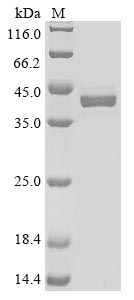Recombinant Mouse Alpha-2-macroglobulin receptor-associated protein (Lrpap1) gets produced using a baculovirus expression system and spans amino acids 248 to 360. The partially expressed protein carries a GFP tag at the N-terminus plus a 6xHis tag at the C-terminus, which helps with both purification and detection. SDS-PAGE analysis confirms the protein reaches greater than 85% purity, making it appropriate for various research applications.
Alpha-2-macroglobulin receptor-associated protein, or Lrpap1, appears to play a critical role in regulating lipoprotein metabolism and endocytosis. It works as a molecular chaperone, helping with proper folding and trafficking of low-density lipoprotein receptor-related proteins. Researchers often turn to Lrpap1 when studying receptor-mediated cellular processes since it may provide insights into lipid metabolism and related disorders.
Potential Applications
Note: The applications listed below are based on what we know about this protein's biological functions, published research, and experience from experts in the field. However, we haven't fully tested all of these applications ourselves yet. We'd recommend running some preliminary tests first to make sure they work for your specific research goals.
Mouse Lrpap1 is a eukaryotic chaperone protein that requires precise folding, proper tertiary structure, and specific domain organization for its functional activity in low-density lipoprotein receptor-related protein (LRP) binding and trafficking. The baculovirus expression system provides a eukaryotic environment that supports proper folding and potential post-translational modifications. However, the partial fragment (248-360aa) represents only a portion of the full-length protein and may lack critical functional domains. The large N-terminal GFP tag (∼27 kDa) is significantly larger than the protein fragment itself (113 aa, ∼12 kDa) and will cause severe steric interference with the protein's functional domains and binding interfaces. The probability of correct folding with functional bioactivity is extremely low.
1. Antibody Development and Validation
This application has severe limitations. While antibodies can be generated, the immune response will primarily target the large foreign GFP tag rather than the small Lrpap1 fragment. Antibodies may not recognize the native, full-length Lrpap1 protein in its physiological context.
2. Structural and Biochemical Characterization Studies
Basic biophysical analysis can be performed, but will not reflect native Lrpap1 structure. The GFP tag will dominate all physical properties, and results will describe an artificial construct rather than the physiological protein. Studies cannot provide meaningful insights into native Lrpap1 biochemistry.
Final Recommendation & Action Plan
This GFP-tagged Lrpap1 fragment expressed in baculovirus is unsuitable for functional studies due to the severe steric interference from the massive GFP tag (27 kDa) relative to the small protein fragment (12 kDa). The GFP tag is more than twice the size of the Lrpap1 fragment itself, dominating all structural and functional properties. Applications 1 and 2 have severe limitations and will not provide insights into native Lrpap1 biology. For reliable Lrpap1 research, use full-length or larger domain constructs with minimal tags expressed in mammalian systems that support proper folding and preserve native functional interfaces.






